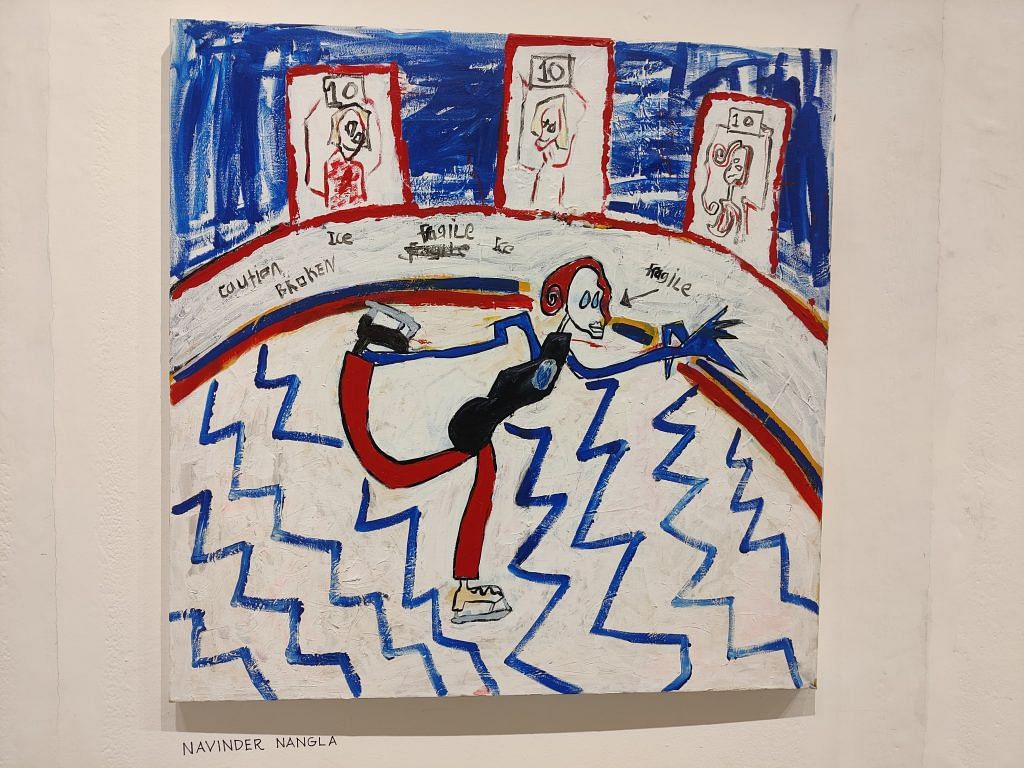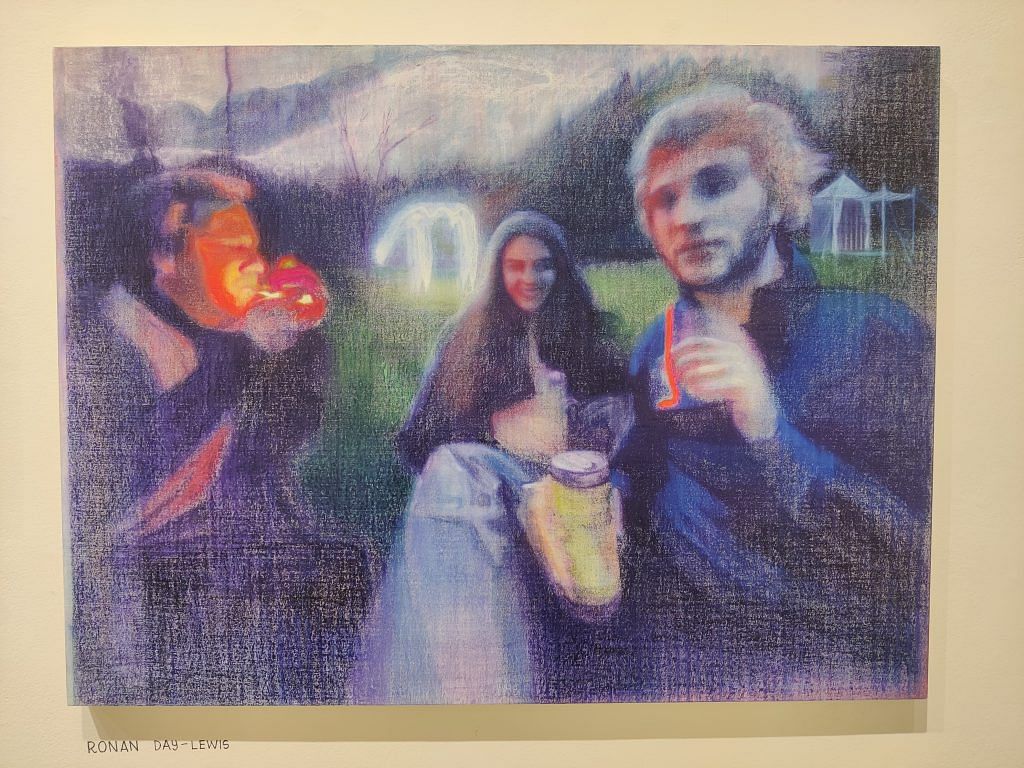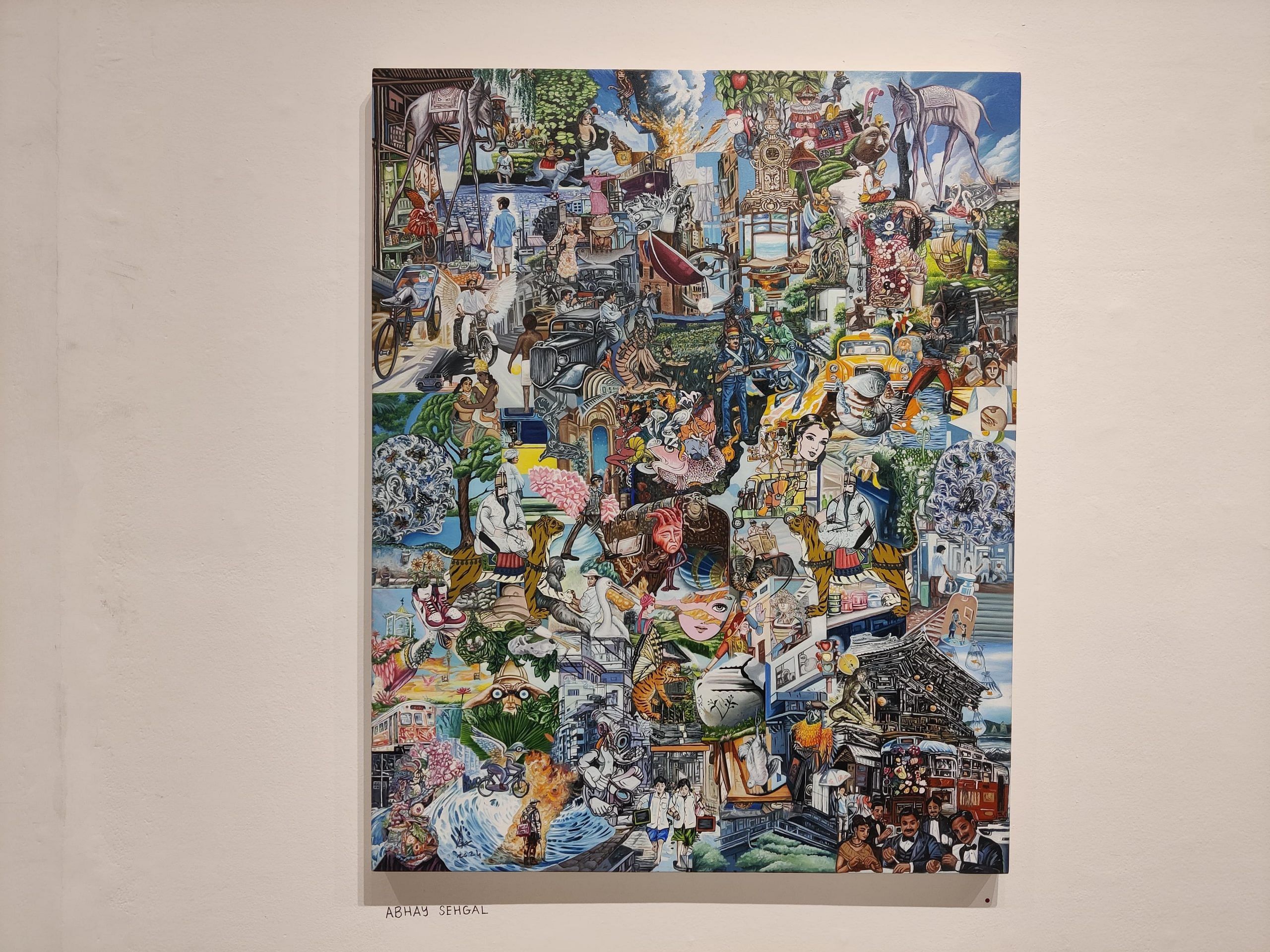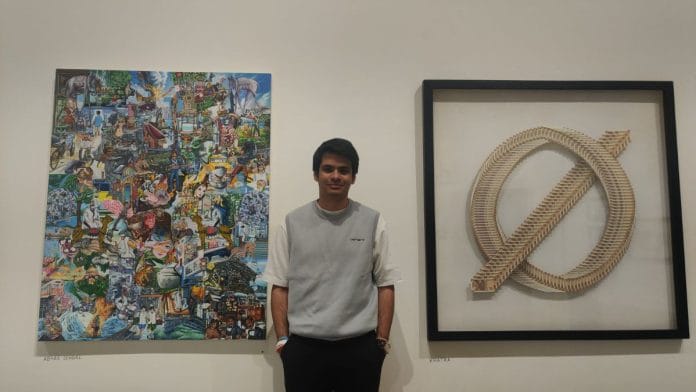New Delhi: In a world that often demands perfection, Navinder Nangla’s art embraces flaws, finding solace and beauty in raw, unapologetic honesty. Smudged and rewritten words, such as “fragile,” reflect his struggle to accept imperfections. The zigzag patterns symbolise instability, mirroring the delicacy and vulnerability of the central figure in his painting, recently featured at an art show in Delhi.
He draws deeply from his experiences with dyslexia. “This piece is about the act we put on to be accepted, hiding our fragility and fears of heartbreak or disappointment. The figure seems to be pointing at itself, acknowledging its own vulnerability while being judged by others,” said Sanya Soni, the walkthrough in charge of the art show, about Nangla’s work.
The third edition of You Cannot Miss This, presented by Artize at Delhi’s Bikaner House, showcased an eclectic mix of contemporary art. With works from artists such as Raihan Vadra, Ronan Day-Lewis, Abhay Sehgal, Akshay Singh, Madhavi Itti Menon, Navinder Nangla, and others, the exhibition celebrated creativity in its simplest form. By blending hyper-contemporary, traditional, photographic, and installation art, it challenged the idea that art must be overly complex to hold value, instead emphasising direct, unpretentious expressions of emotion and thought.

“Our goal is to make art and the creative field freer, more relaxed, and fun. We’re playing with smaller ideas, allowing creativity to flow without the pressure of imposing grand concepts on our audience,” said Raihan Vadra, a visual and installation artist who was also the show’s chief curator.
Exploring the supernatural & personal
Paintings by Ronan Day-Lewis, a New York-based artist who’s also the son of veteran Hollywood actor Daniel Day-Lewis, involve layering various mediums. They start with stencils created from paint, followed by details added with oil pastels and colour pencils. The result is a collection of works that often appear blurry, almost like overexposed photographs. One striking element in Day-Lewis’s artwork is his use of ghostly figures. He explores the intersection of the earthly and the supernatural, suggesting that art can bridge the gap between these realms.

“He portrays scenes that seem to occur in isolated, almost unreachable places, evoking a sense of mystery. The white glowing figure seems to hint at something beyond the physical realm. Maybe it’s a soul trapped within reality that is trying to go back home,” Soni explained.
His works invite viewers to contemplate how art can close the distance between what we understand as ‘real’ and what we imagine to be beyond our world.
Another painting by artist Abhay Sehgal explores the realms of dreams and psychology. Through a collage of his personal experiences, dreams, and interests, he blends elements of Mughal miniatures and Indian texts, with each figure telling a unique story—some nostalgic, others mythical.

“It [the art show] is interesting for me because, in my own work, I dive deep into philosophical contexts and explore how they translate into immersive experiences and installations. But in this show, we’re focusing on smaller ideas to make the space more accessible and embrace a more approachable approach,” Vadra told ThePrint.
Also read: Sindhis have been missing in India’s Partition story. Now, they finally get an exhibition
Redefining art shows
The journey of the You Cannot Miss exhibit began last February 2023, when a group of artists, dissatisfied with the limitations of traditional galleries, united with a shared vision of creating an independent art show. Their goal was to present art in a way that felt fresh and unbounded by conventional gallery structures, challenging the idea that art must be overly complex or require deep analysis to be meaningful. Accessible, engaging, and unpretentious, the show proves that art can seamlessly find its way into every life, each encounter unique and personal.
A big picture or takeaway point is missing. And that’s deliberate.
“We wanted to bring in people who might not already be into art—people interested in fashion, music, or design. So, we started adding events around the art show to draw in a larger, more diverse crowd,” said Vadra.
Growing up in a political family as the son of Congress leader Priyanka Gandhi, Vadra was always aware of the public’s perception of him, shaped by his family’s prominence. “I’ve always known that people look at me and my family more than others. It makes it harder to express your ideas freely, especially when those ideas might be a little out of the box. For most people, the image they have of me doesn’t include art or photography, and that makes it a real challenge to differentiate myself from those preconceived notions,” he said. “But at the same time, it’s an interesting exercise to navigate this, even if it’s difficult.”
As an artist, he has always sought to define his work on his terms, distancing it from his family’s political legacy. “My family’s legacy’s impact on my work is not any different from any other artist’s family’s impact on that particular artist’s work,” he said. Despite being surrounded by political influences, Vadra says that his personal experiences, rather than his lineage, shape his creative expression.
(Edited by Zoya Bhatti)







Stay far away from politics! Don’t let your family’s toxic history drive you into more muck! This generation has legal, economic, civilizational and spiritual challenges the oldies will never get. Find your niche (which it seems to be art, bro is a big DHH guy too) and make it reach new heights. That’s the only way to contribute.
Dharm ki jai ho, adharm ka naash ho ?.
PS it’s okay to vote against your relatives or go against the ideology of the older generation we’ve all been there :p.
❤️❤️